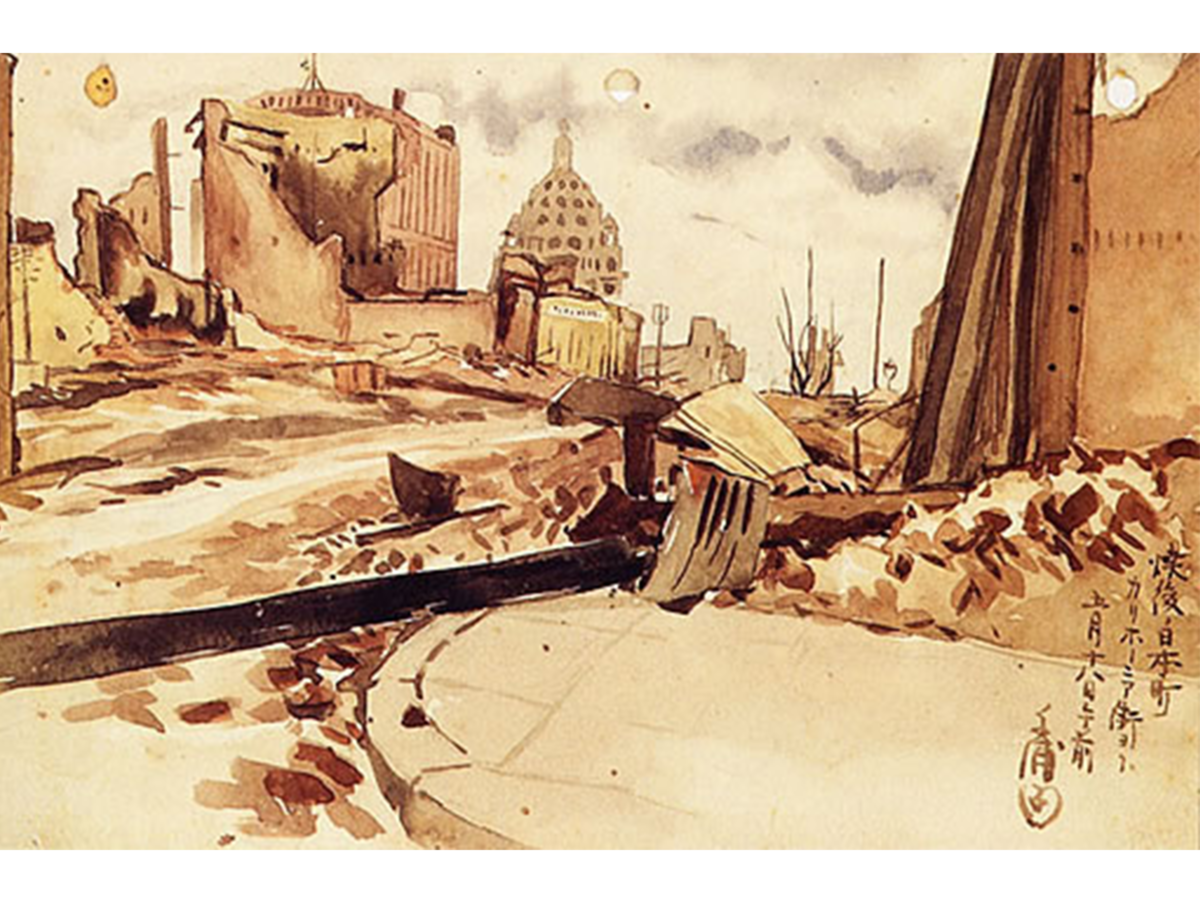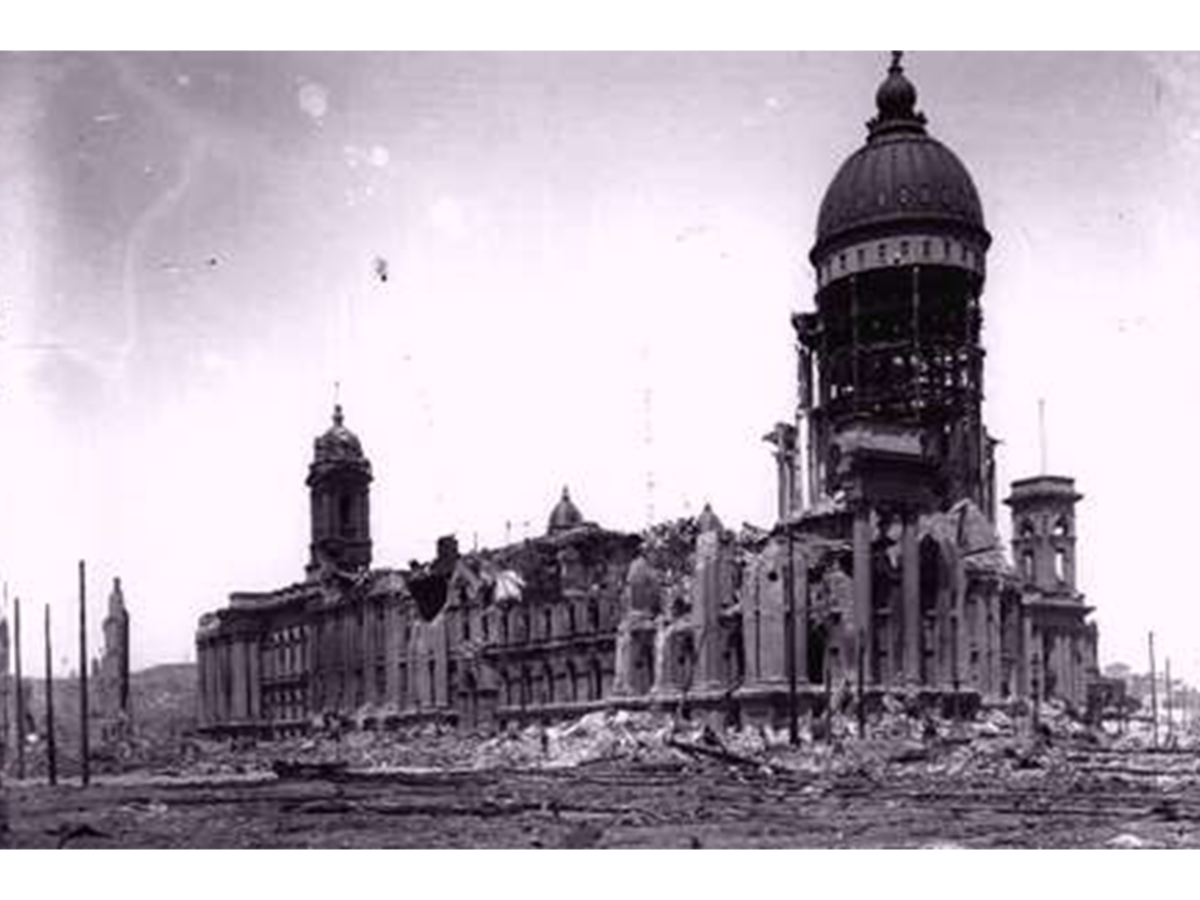Activity
1906 San Francisco Earthquake and Primary Source Documents
Objective: Students will explore primary documents, such as Chiura Obata's paintings, to understand the severity of the 1906 San Francisco earthquake.

View Examples of Visual Primary Sources
Shortly after artist Chiura Obata immigrated to California from Japan, the 1906 San Francisco earthquake and fire ravaged the city. This natural disaster upended life in the Bay Area. Obata created artworks showing the mayhem and destruction the earthquake caused.
The following lesson plan was written by Doug DuBrin, an English and history teacher as well as an editor and writer for PBS. It has been modified to include Chiura Obata’s artwork and biography in honor of APA Heritage Month. The original lesson plan is available on the PBS website.
“The 1906 San Francisco earthquake and the resulting fires were one of the most devastating natural disasters in United States history. Recent estimates place the death toll from the quake at close to 3,000, far more than the original tally of around 300. The physical devastation to the city itself was immeasurable, in great part due to the lack of structural reinforcements that we take for granted today.”
Source: PBS News Hour Lesson Plans
Common Core Standards
HSS-3.3 Students draw from historical and community resources to organize the sequence of local historical events and describe how each period of settlement left its mark on the land.
W.4.7 Conduct short research projects that build knowledge through investigation of different aspects of a topic.
W.4.8 Recall relevant information from experiences or gather relevant information from print and digital sources; take notes, paraphrase, and categorize information, and provide a list of sources.
W.4.9.a,b Draw evidence from literary or informational texts to support analysis, reflection, and research.
RI.5.8 Explain how an author uses reasons and evidence to support particular points in a text, identifying which reasons and evidence support which point(s).
RI.5.9 Integrate information from several texts on the same topic in order to write or speak about the subject knowledgeably.
LIB.6.4.3 Appreciate and respond to creative expressions of information: a. Demonstrate a variety of methods to engage the audience when presenting information b. Appreciate a range of creative forms of expression c. Evaluate one’s own research process and that of others in a respectful, cooperative, and productive way.
Associated Standards
ESS1.C The History of Planet Earth – Local, regional, and global patterns of rock formations reveal changes over time due to earth forces, such as earthquakes. The presence and location of certain fossil types indicate the order in which rock layers were formed.
Materials
Internet access
Primary source documents from http://www.sfmuseum.org/1906/ew.html
Alternative primary source documents from
https://www.archives.gov/exhibits/sf-earthquake-and-fire/earthquake-fire.html
Background articles
http://www.pbs.org/wgbh/amex/ansel/peopleevents/e_earthquake.html
http://quake.wr.usgs.gov/info/1906/
http://www.pbs.org/wnet/savageearth/earthquakes/
Procedure
- Introduce the 1906 earthquake by sharing the above background information and showing Obata’s rendering of Japantown, along with the image of San Francisco City Hall
- (Optional) Use the following resource to study the science of earthquakes prior to this lesson: Teacher-Guide Earthquakes
- Provide definitions for students of primary and secondary source documents. Explain that students will be examining primary source documents.
- Primary Source – provides raw information and first-hand evidence. Examples include interview transcripts, statistical data, and works of art. A primary source gives you direct access to the subject of your research.
- Secondary Source – provides second-hand information and commentary from other researchers. Examples include journal articles, reviews, and academic books. A secondary source describes, interprets, or synthesizes primary sources. Primary sources are more credible as evidence, but good research uses both primary and secondary sources.
- In order to gain a thorough understanding of the scope and impact of the disaster, have the students carefully read the background articles provided above prior to the lesson.
- Copy and randomly distribute to each member of the class a different firsthand account (there are 32 provided in the sfmuseum.org link above).
- Divide the class into groups of 3–4 students.
- Have each student read an account out loud to the other group members, while attempting to capture the mood and tone of the piece as it was written. For example, if the narrative is describing the horrible destruction of the quake and resulting fire, insist that the tone of the reading reflects it (i.e., the student should not be laughing while reading, but rather projecting a somber mood).
- Once each student has completed reading the narratives aloud, have the groups critically examine the texts by answering the following:
- What commonalities did you find in the content of the narratives? In other words, what are the shared memories of the experience?
- Why might certain memories stand out more than others? What might cause a person to vividly remember the color of a lamp shattered by the quake when he/she would not ordinarily recall such a detail?
- How might you identify the mood of the narratives? Are they all necessarily dark?
- Could there be a sense of relief due to the simple fact of having survived? When recounting separate parts of the disaster, does the mood change within the individual narrative itself? If so, why might that be?
- Reconvene as a class to discuss the overall role and value of first hand historical accounts. To guide the discussion, you may wish to ask the following:
- In what ways do personal narratives enrich our study of history? What do they provide that objective, analytical accounts of historical events do not?
- In what ways are personal narratives limiting in their view of history? What do they lack as far as enriching our understanding of historical events?
- How trustworthy are the firsthand accounts of historical events? What individual biases or external influences could get in the way of “truthful” reporting?
- How does the age, gender, or social status of the eyewitness influence the way in which he/she views the disaster?
- Does the media today rely on firsthand accounts of events to report the news? Are reporters themselves discouraged from expressing their own opinions? In what ways does the news coverage of major events differ between television reporting and print media?
Extension Activity: Analyzing Other Primary Documents
For a follow-up activity, the procedures above can be applied to the study of firsthand accounts of other seminal events in American history. Included below are useful links to various other primary-document resources:
http://www.archives.gov/research/arc/
http://memory.loc.gov/ammem/index.html
http://historymatters.gmu.edu/browse/manypasts/





